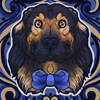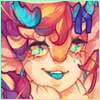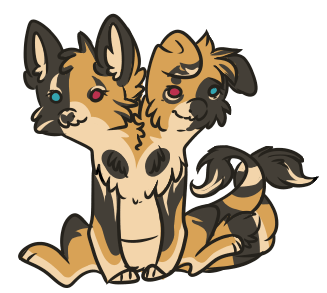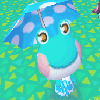Arbex (Round extended until 2/17)
Forum rules
Art theft is not tolerated here. Do not copy/trace/edit/use anybody's pictures without their express permission.
If you are unsure, read the full art rules here.
Art theft is not tolerated here. Do not copy/trace/edit/use anybody's pictures without their express permission.
If you are unsure, read the full art rules here.
Re: Arbex Auctions (Auction open)
Are we able to purchase tokens right now even if the customs are closed as of right now? Sorry if this was stated im blind at times C:
-

Mirandamay - Posts: 2195
- Joined: Fri Sep 17, 2010 7:32 am
- My pets
- My items
- My wishlist
- My gallery
- My scenes
- My dressups
- Trade with me
Re: Arbex Auctions (Auction open)
Mirandamay wrote:Are we able to purchase tokens right now even if the customs are closed as of right now? Sorry if this was stated im blind at times C:
Yup. :] Tokens are always available for purchase unless specifically stated in the custom section.
-

June Bug - Official Artist
- Posts: 14747
- Joined: Tue Nov 03, 2009 5:05 am
- My pets
- My items
- My wishlist
- My gallery
- My scenes
- My dressups
- Trade with me
Re: Arbex Auctions (Auction open)
Names are my weakness. D:
I came up with Sylvie for her, mum said Mink or Minkie. I dunnooo.. D:
*flails and runs in circles*
*runs into the wall*
*falls over*
*dead*
x.x;
I came up with Sylvie for her, mum said Mink or Minkie. I dunnooo.. D:
*flails and runs in circles*
*runs into the wall*
*falls over*
*dead*
x.x;
-

Veggievampire - Posts: 6700
- Joined: Thu Oct 02, 2008 2:56 am
- My pets
- My items
- My wishlist
- My gallery
- My scenes
- My dressups
- Trade with me
Re: Arbex Auctions (Auction open)
Kamaliah wrote:Mirandamay wrote:Are we able to purchase tokens right now even if the customs are closed as of right now? Sorry if this was stated im blind at times C:
Yup. :] Tokens are always available for purchase unless specifically stated in the custom section.
Alrighty, thanks C: Sent a trade <3
-

Mirandamay - Posts: 2195
- Joined: Fri Sep 17, 2010 7:32 am
- My pets
- My items
- My wishlist
- My gallery
- My scenes
- My dressups
- Trade with me
Re: Arbex Auctions (Auction open)
I would like to bid this on pen 2 please:
http://www.chickensmoothie.com/accounts/viewgroup.php?groupid=810365&sid=dc0d6e09cfeed3253ebcb262ba2be143&userid=46298
PS Changed my user name from Merveille to iSky ;]
http://www.chickensmoothie.com/accounts/viewgroup.php?groupid=810365&sid=dc0d6e09cfeed3253ebcb262ba2be143&userid=46298
PS Changed my user name from Merveille to iSky ;]
-

paola . - Posts: 8477
- Joined: Sat Sep 05, 2009 8:08 am
- My pets
- My items
- My wishlist
- My gallery
- My scenes
- My dressups
- Trade with me
Re: Arbex Auctions (Auction open)
herpderp, still not finished, but I'm actually remembering that I need to close the auction. o3o
So, Auction closed now.
Winners are as follows:
Pen 1: Auto'd by iBrevity
Pen 2: iSky
Pen 3: Auto'd by Veggievampire
Congrats! :] Send the trade when you get the chance and she'll be put under your name.
-waddles away for a minute to watch Pretty Little Liars-
So, Auction closed now.
Winners are as follows:
Pen 1: Auto'd by iBrevity
Pen 2: iSky
Pen 3: Auto'd by Veggievampire
Congrats! :] Send the trade when you get the chance and she'll be put under your name.
-waddles away for a minute to watch Pretty Little Liars-
-

June Bug - Official Artist
- Posts: 14747
- Joined: Tue Nov 03, 2009 5:05 am
- My pets
- My items
- My wishlist
- My gallery
- My scenes
- My dressups
- Trade with me
Re: Arbex Auctions (Auction open)
They were really pretty this round(:
Can't wait to use my custom,, bahaha
PLL!
Can't wait to use my custom,, bahaha
PLL!
-

Soccerlvr - Posts: 3087
- Joined: Fri May 29, 2009 10:50 am
- My pets
- My items
- My wishlist
- My gallery
- My scenes
- My dressups
- Trade with me
Re: Arbex Auctions (Auction open)
Gah! I didn't know someone posted a bit for #2! Darn, I really wanted her.

hello!! i am retired, but feel free to message me if you ever need some help <3
Helpful links for New Members!
Adopt a Newbie - Newbie Guide & Index - Help Tickets - GHAA: Free Pets for Newbies
-

Lady Masquerade - Posts: 22984
- Joined: Sun Aug 30, 2009 3:44 am
- My pets
- My items
- My wishlist
- My gallery
- My scenes
- My dressups
- Trade with me
Re: Arbex Auctions (Auction open)
Thank you!^^ I'll send my trade and her name shall be Primavera, Prima or Vera for short!^^
-

paola . - Posts: 8477
- Joined: Sat Sep 05, 2009 8:08 am
- My pets
- My items
- My wishlist
- My gallery
- My scenes
- My dressups
- Trade with me
Re: Arbex Auctions (Auction open)
Alrighty, well, this is taking a lot longer than I expected, but I finally finished the male lines, filled them in with my new nameless boy, and got some basic info filled out. I haven't decided on a species name yet so for now, they are just 'creatures'. xD
Take a read~

1. The ends of the horns grow into a shape resembling the rounded snout of a serpent-like creature. The hair that sprouts from the 'mouth' is the first part of the growth to appear and is fully grown out before the horns begin to sprout at a year old. The 'eyes of the beast' are genetically designed to be the color of it's holder's eyes, giving the illusion that there are three entities rather than one.
It is thought that these unique horns are used to confuse and scare potential predators as well as to intimidate rival males.
2. The bulk of the horns have a strange structural build to them. The segments are each hollow and separate from each other. They have joints that keep them securely attached to each other, but allow the units to sway, adding to the illusion of life and giving the animal a distinctive, elegant, swaying gait. The animals have a remarkable balance and grace that allows them to carry these horns without trouble.
Unlike it's relatives, these animals do not butt heads in disputes, but instead engage in a complex intimidation battle, proving themselves to have better breeding. Size is usually not a factor, but instead, individuals with superior abilities to make their sets appear more life-like combined with the details (symmetrical spiking, more realistic 'eyes', better subtle 'head' shaping, etc.) and the quality of their stone (see point # 8), are more successful than others.
3. The head shape is reminiscent of the wild goats it is related to.
4. Has very large, wide ears.
5. Has a thick, strong neck, ideal for holding it's somewhat heavy head. It's beard grows long and continues down it's neck to shorten under it's belly, then to grow slightly longer once more before finally ending by it's hind knees.
6. One blunt, bony spike rises from each shoulder blade. The precise purpose of this is unknown.
7. Thick, sturdy legs hold it's considerable weight well.
8. A single Horn-like appendage sprouts from it's hind end, at the base of it's tail. It curls at the end to hold a stone. This stone is made of a very heavy mineral found in the hills of the animal's home. It acts as a balance for the heavy horns.
The mineral stone is found in many colors and each is chosen based on the eye color of it's holder (which is thought to be determined through reflection observation in water). At around two years, the horn has grown out and curved enough to place the stone in it's grasp for the rest of the horn to grow around and out with.
At a year old, individuals excavate rough chunks of the mineral in their color spend the next year wearing it into a smooth, round shape to be ready for placement (with the help of their elders) at two years. Those who do a better job of smoothing their stones are more patient and perseverant than those with rougher stones.
9. Has a long, flowing, horse-like tail.
10. Large eyes with rectangular pupils.
11. Three usable toes on each foot, five in total, each tipped with a hard, sturdy hoof.
Other info:
Males of this species are around 4'6" tall at the shoulder (not including the blunt spikes), females are around 4'.
Coat coloration is always in the neutral range (browns and grays). The only features that can, and usually do, stray from this are the eyes, 'beast eyes', and stone, which all correspond.
They are neither strictly monogamous nor polygamous, it really depends on the individual. It is uncommon to find one alone, they usually travel in pairs or small family groups and they frequently gather into larger friendly groups around common grazing grounds and watering holes.
Though they are most closely related to cliff-dwellers, they find it difficult and unnecessary to climb like them as they have virtually no natural predators. Instead, they live in mountain valleys and foothills in various cold-weather climates.
Take a read~

1. The ends of the horns grow into a shape resembling the rounded snout of a serpent-like creature. The hair that sprouts from the 'mouth' is the first part of the growth to appear and is fully grown out before the horns begin to sprout at a year old. The 'eyes of the beast' are genetically designed to be the color of it's holder's eyes, giving the illusion that there are three entities rather than one.
It is thought that these unique horns are used to confuse and scare potential predators as well as to intimidate rival males.
2. The bulk of the horns have a strange structural build to them. The segments are each hollow and separate from each other. They have joints that keep them securely attached to each other, but allow the units to sway, adding to the illusion of life and giving the animal a distinctive, elegant, swaying gait. The animals have a remarkable balance and grace that allows them to carry these horns without trouble.
Unlike it's relatives, these animals do not butt heads in disputes, but instead engage in a complex intimidation battle, proving themselves to have better breeding. Size is usually not a factor, but instead, individuals with superior abilities to make their sets appear more life-like combined with the details (symmetrical spiking, more realistic 'eyes', better subtle 'head' shaping, etc.) and the quality of their stone (see point # 8), are more successful than others.
3. The head shape is reminiscent of the wild goats it is related to.
4. Has very large, wide ears.
5. Has a thick, strong neck, ideal for holding it's somewhat heavy head. It's beard grows long and continues down it's neck to shorten under it's belly, then to grow slightly longer once more before finally ending by it's hind knees.
6. One blunt, bony spike rises from each shoulder blade. The precise purpose of this is unknown.
7. Thick, sturdy legs hold it's considerable weight well.
8. A single Horn-like appendage sprouts from it's hind end, at the base of it's tail. It curls at the end to hold a stone. This stone is made of a very heavy mineral found in the hills of the animal's home. It acts as a balance for the heavy horns.
The mineral stone is found in many colors and each is chosen based on the eye color of it's holder (which is thought to be determined through reflection observation in water). At around two years, the horn has grown out and curved enough to place the stone in it's grasp for the rest of the horn to grow around and out with.
At a year old, individuals excavate rough chunks of the mineral in their color spend the next year wearing it into a smooth, round shape to be ready for placement (with the help of their elders) at two years. Those who do a better job of smoothing their stones are more patient and perseverant than those with rougher stones.
9. Has a long, flowing, horse-like tail.
10. Large eyes with rectangular pupils.
11. Three usable toes on each foot, five in total, each tipped with a hard, sturdy hoof.
Other info:
Males of this species are around 4'6" tall at the shoulder (not including the blunt spikes), females are around 4'.
Coat coloration is always in the neutral range (browns and grays). The only features that can, and usually do, stray from this are the eyes, 'beast eyes', and stone, which all correspond.
They are neither strictly monogamous nor polygamous, it really depends on the individual. It is uncommon to find one alone, they usually travel in pairs or small family groups and they frequently gather into larger friendly groups around common grazing grounds and watering holes.
Though they are most closely related to cliff-dwellers, they find it difficult and unnecessary to climb like them as they have virtually no natural predators. Instead, they live in mountain valleys and foothills in various cold-weather climates.
-

June Bug - Official Artist
- Posts: 14747
- Joined: Tue Nov 03, 2009 5:05 am
- My pets
- My items
- My wishlist
- My gallery
- My scenes
- My dressups
- Trade with me
Who is online
Users browsing this forum: No registered users and 4 guests






